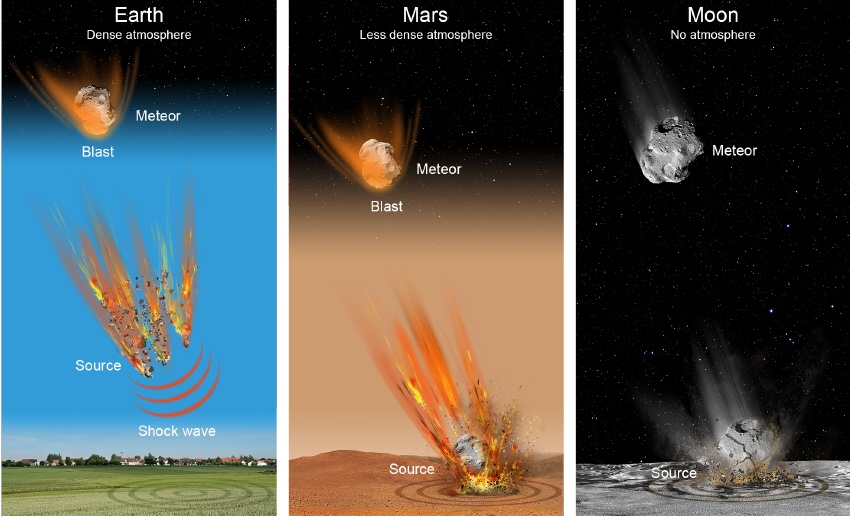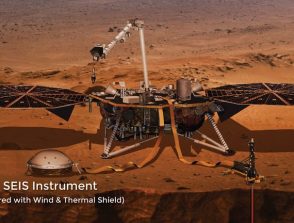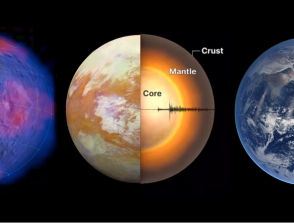Analysis and modeling of meteor impact and airburst generated seismic waves on terrestrial planets with atmosphere.

Start: 01 October 2014
End: 07 September 2018
Supervisors :
Philippe Lognonné
Related observatories :
InSight Observatory
Related teams :
Planetology and Space Sciences
Status: Defended
Meteor impacts constitute a source of paramount importance for Planetary Seismology, since their locations and, in some cases, their occurence times can be accurately known from orbiters, tracking or visual inspections. Their contribution is enhanced in the case of a seismic experiment with one seismometer, as the SEIS (Seismic Experiment of Interior Structure) of the imminent Martian mission “InSight” (Interior Exploration using Seismic Investigations, Geodesy and Heat Transport), as the known location allows a direct inversion of differential travel times and wave forms for structure identification.
Meteor impacts generate body and surface seismic waves when they reach the surface of a planet. When they explode into the atmosphere, due to ablation, they generate shock waves, which are converted into linear, seismic waves in the solid part and acoustic waves in the atmosphere. This effect can be modeled as it corresponds to the amplitude of Rayleigh and other Spheroidal normal modes produced by the atmospheric/ground coupling effects.
This PhD dissertation is focusing on the investigation and modeling of the meteor generated Rayleigh waves. A brief recall to the advance of planetary science with focus on planetary seismology and the study of meteor impact seismic sources is presented. Thereafter the theory concerning the propagation of meteor generated shock waves in the atmosphere and in the ground is presented in further detail, with the implementation in associated events. In the case of the atmosphere, the effect of transition from a highly nonlinear propagation regime to the linear one is presented for a meteoroid entering the Earth’s atmosphere with supersonic velocity. In the case of the subsurface, an example provided by hydrocode runs, for a meteor impact on the Moon, is investigated, in order to present similar processes in a comparative analysis of the processes in different planetary objects.
Thereafter, an inversion of the seismic source of Chelyabinsk superbolide is performed, in order to examine the properties of the source in Earth atmosphere. An approach of a linear source is developed in order to model a linear source consisted by a series of consecutive point sources, based on a provided trajectory. The calculation of synthetic seismograms of Rayleigh waves associated to the event is performed by the summation of normal modes of a model of the solid part and the atmosphere of the planet. Through an inversion technique based on singular value decomposition, solutions for the moment magnitude are provided. The inversion results indicate the presence of a Doppler effect, associated with the directivity of the source. In order to assess the potential role of the 3D structure to the obtained results, the Rayleigh waves are also modeled for a source located on the ground, with the use of a different modeling technique, based on spectral element method software.
In the case of Mars, the same method is used in order to provide waveforms associated to impacts on the planetary surface or in low altitudes in the martian atmosphere. It is shown that the contribution of the fundamental spheroidal solid mode is dominating the waveforms, compared to that of the first two overtones. The comparison of amplitudes shows that small impactors (diameter of 0.5 to 2 meters) can be detected by the SEIS VBB (Very Broad Band) seismometer of InSight mission, only in the higher frequencies of Rayleigh waves (higher than 0.16 Hz), even in short epicentral distances (for example in the case of the performed calculations for 5◦). An analysis based on impact rate estimations enables to calculate the number of detectable events of meteor impacts for projectiles with diameter greater than 1 meter and it led to the conclusion of 6.7 to 13.4 detectable impacts during a Mars year, the nominal operational period of InSight mission.






